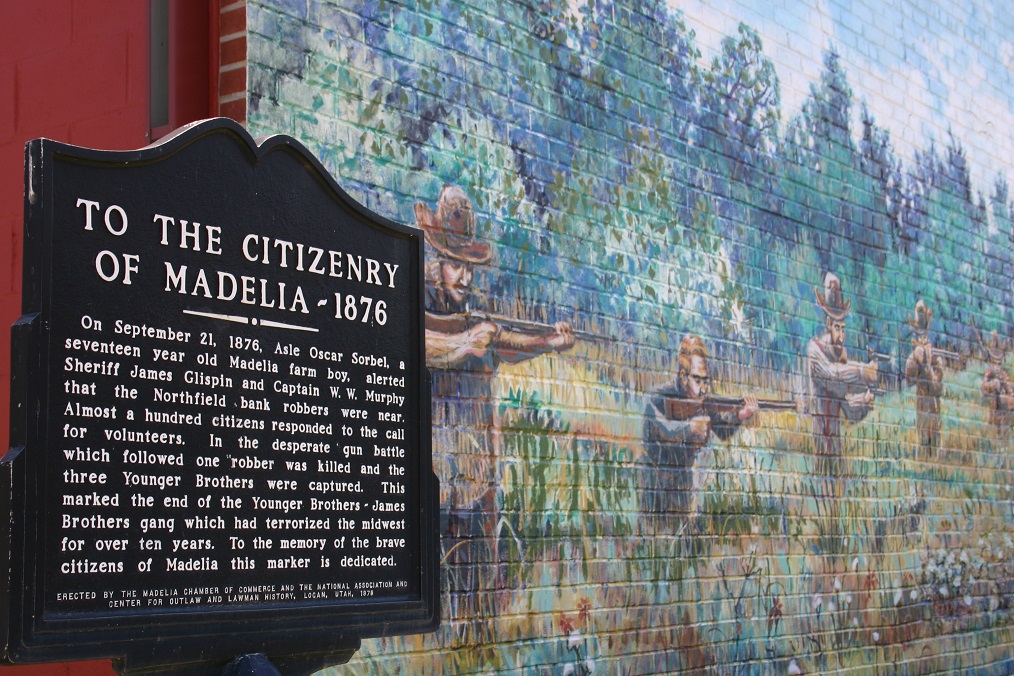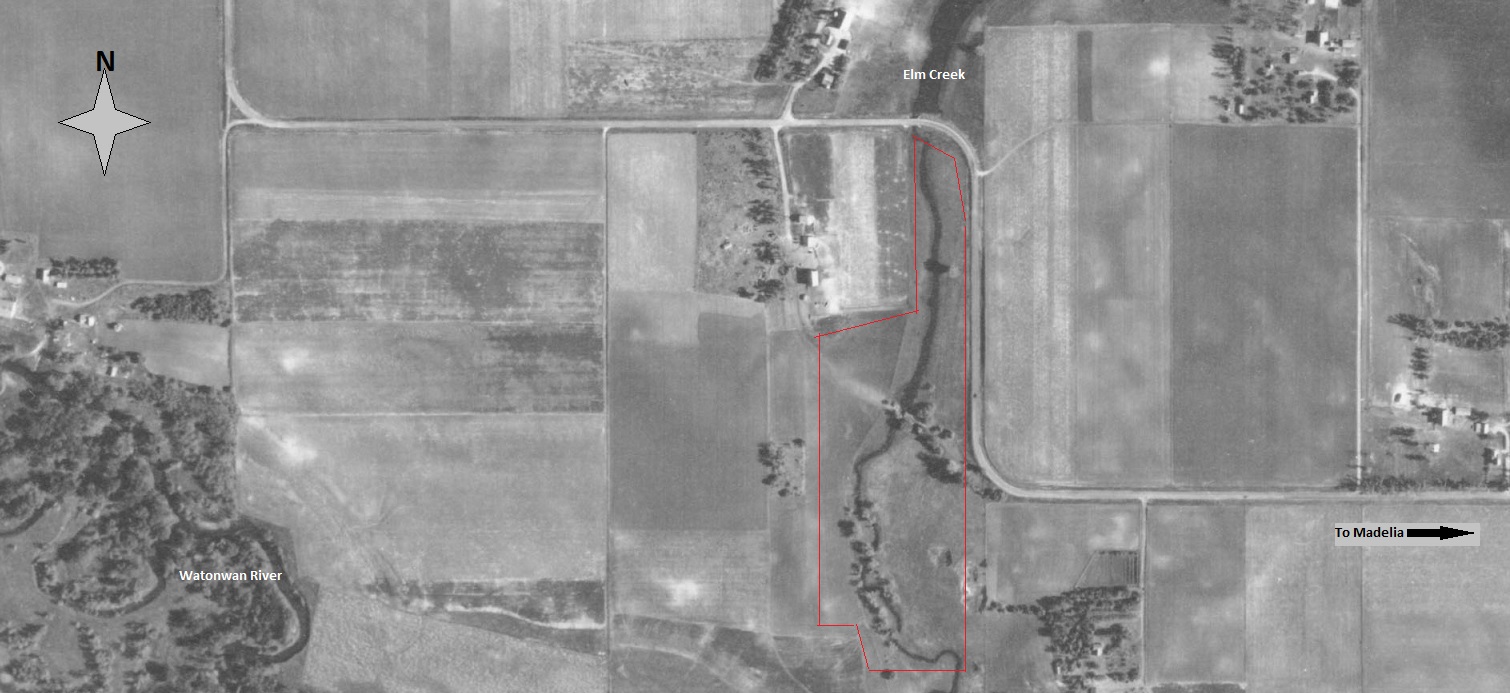Moments in southwestern Minnesota history:
Sept. 21, 1876, west of the city of Madelia, along the banks of the Watonwan River: Shots fired.
May 1921, west of the city of Madelia, not far from the banks of the Watonwan River: Shots fired again.
Honestly, one shouldn’t make much of the similarities. They are coincidence, nothing more. The “shots” couldn’t have been more dissimilar. And although the first incident stands as probably the most significant event in Watonwan County history, the second, by comparison, is about as historically significant as Rory McIlroy clipping his fingernails next Wednesday.
Dispensing with the historically significant first:
In September 1876, three members of the James-Younger gang, which had been foiled 14 days earlier in an attempt to rob the First National Bank of Northfield, made their way through Madelia and then westward as they fled justice through the small towns of southern Minnesota. On Sept. 21, three of the Younger brothers — Cole, Bob and Jim — plus fellow gang member Charlie Pitts skulked through an area known as Hanska Slough (it no longer exists, having been mitigated via drainage ditch) until making a last stand in the Watonwan River, just south of the town of La Salle. A gunfight ensued. Pitts was shot and killed, and the Youngers were captured.
The Northfield bank robbery is widely considered the most famous in U.S. history. The Youngers’ attempted escape has been retold in book, magazine and even poetry form and has been the subject of preservation and re-enactment.

As for the second Madelia-area event, only a handful of souls know anything about it. Stacked up against the story of the flight of the Youngers, may we present a few dozen paragraphs of pure anticlimax:
Forty-four and a half years after and 5.5 miles east of the site of the Youngers’ capture, different brands of foursomes, less threatening than three Youngers and a Pitts, made their way to an area west of Madelia, a few hundred yards north of the Watonwan riverbank.
The Madelia Times-Messenger of May 27, 1921, explains:
“The Madelia Golf Club is now a reality,” the newspaper reported, “a sufficient number having signed the membership roll to make a go of it.
“At a meeting held Monday night, Dr. R.J. Hodapp was made temporary chairman and Dr. M.J. James acted as temporary secretary. It was decided to place the membership fee at $5.00 for this season, and each membership to include the immediate family of the person joining the club.
“A portion of the Siron pasture, comprising about 25 acres, has been secured for the course, and those who are acquainted with the game claim that this tract will make as fine a golf course as is to be found anywhere. It will be a nine-hole course, and there are a sufficient number of mental and physical hazards to satisfy the most exacting.”
” … It is expected that grounds will be ready for play on Memorial Day.”
Madelia Golf Club, contrary to its “best course anywhere” boast, might be described by a term that usually makes me blanch: pasture pool. It’s a term used in jest at best and in the pejorative at worst. But truth be told, it fits the old Madelia GC.
The course was established on an attractive piece of land straddling Elm Creek, two miles west and slightly north of downtown. But its features were rudimentary, in a golfing sense. A Times-Messenger story from May 6, 1921, foreshadowed as much:
“Golf seems to be generally considered a rich man’s game, but we are told that such is not necessarily the case,” the newspaper reported. “Elaborate grounds, club houses, banquets, etc., are not at all necessary. Any old pasture of fifteen or twenty acres will do for a nine-hole course, and its use will not in any way interfere with the cattle which are pastured upon it.”
Bessie, here we come, mashies in hand.
The Madelia course, laid out by four members of the club’s grounds committee, was maintained by livestock grazing on the Siron pasture, which actually was part of the Fred Tiedeken farm, according to Barb Nelson of the Watonwan Historical Society. Although most Minnesota small-town courses of the 1920s and ’30s featured sand greens, which offered at least a modicum of refinement in rolling a ball across the land, the Madelia course had natural-grass greens, probably choppy and less-than-reliable. And golfers occasionally had the distinct pleasure of having to wash their cowpie-tainted golf balls off in nearby Elm Creek, according to Adeline Yates, whose father, Buster Yates, grew up nearby and wrote about the course in his 1986 book, “Seventy-Five Years on the Watonwan.”
“When the course was next to our place,” Buster Yates wrote, “my neighbor buddy, Lucius Siron, and I caddied for the players at a dime a round of nine holes. In our spare time we hunted lost balls and sold them back to people. During hard rains the balls would wash down the hills into the creek from where we would pull ’em out with a garden rake. The old creek produced more than golf balls; in the spring of the year bullheads, northern and walleyed pike and others headed north out of the river for Wilson Lake spawn. (Note: Wilson Lake lies 1.5 miles to the north.)

“During these years the golfers didn’t have the benefit of daylight saving time for afternoon golfing and a clubhouse for celebrating afterward. Consequently, the course was buzzing with activity at daylight on summer days. Merchants played a round before opening their shops for the day.
“The golf club hired George Lassak, night operator at the railroad depot for part time service in keeping the greens in shape. The grass on the rest of the course was clipped short by our band of a hundred sheep. George didn’t have more than fifty dollars’ worth of tools. A hand push lawn mower, a few rakes and shovels, plus free help from our sheep kept a well- groomed golf links.”
Madelia Golf Club’s inaugural season appears to have been a success. On Oct. 21, 1921, the Times-Messenger filed this note: “These beautiful October mornings find many of our golf enthusiasts on the links bright and early. There is no better tonic than a chase after the little white ball before breakfast.”
On March 20, 1922, Madelia Golf Club drew up articles of incorporation. In late June 1922, the club announced it would be staging a tournament — single-elimination, match play, with handicap — to run through the Fourth of July. And a piece of potentially big news came later that summer. Doc Hall made the announcement with a piece written for the Aug. 18 edition of the Times-Messenger:
“William Clark, professional of the Oak Ridge Country Club of Minneapolis, and a nationally known golf course architect, laid out the nine-hole course of the Madelia Golf Club, Wednesday. He was assisted by several of the members who volunteered their services for the day.
“Mr. Clark was somewhat puzzled by the topography of the land but finally succeeded in laying out what promises to be an extremely ‘sporty’ golf course.
“The total length of the nine holes will be approximately 2880 yards, the shortest hole being 125 yards in length and the longest 550 yards. The creek and sand pits and several hills are used to good advantage in providing the necessary hazards. Mr. Clark remarked on first seeing the course that the land was peculiarly adapted to golf purposes. Only two holes, the third and ninth, will be trapped.
” … After he was through someone asked Mr. Clark how the Madelia course would compare with other courses elsewhere in the state. He replied, saying, that outside of some in the Twin Cities, the local course would surpass anything that he knew of in the state. He said that the old course was only ‘cow pasture pool’ but that now it could be classed as a real golf course.
“Completing his work here, Mr. Clark returned to Minneapolis on the 5:01 train and promises to send the necessary blue prints and instructions for the building up of the course. As soon as these are received the officials of the club will endeavor to start as soon as possible on the construction of the course. In all probability the club members will be able to play over the new course this fall. Grass will be seeded shortly after September 1st and the greens will be staked and planted. A rough estimate of the par of the new course will be 36, but we venture to say that no one will shoot any par golf this year.”
It was a brush with greatness, or at least prettydarngoodness. William Clark was indeed a noted golf course architect. He designed or contributed to the design of at least a dozen Minnesota layouts, including Oak Ridge in Hopkins; Northfield Golf Club; Superior (now Brookview) in Golden Valley; Minneapolis municipal courses Columbia, Armour (now Gross), Southwest (now Meadowbrook) and Glenwood Park (now Wirth); and Chisago Golf Club, now a lost course in Chisago City.
Clark’s plans for Madelia Golf Club never came to pass. The historical society’s Nelson, in conducting extensive research of the Times-Messenger, found no evidence that the club ever made the improvements Clark suggested. By October 1922, the club was in financial distress and seeking an assessment of $10 per member to improve the grounds, a request gussied up by a social gathering and dinner that included “fried chicken … potatoes in various styles, fruit salads, rolls, jelly, apple and pumpkin pie, cheese and coffee,” the newspaper reported.
(I’ll be right over with a 10 spot, if it’s not too late.)
Beyond that, references to Madelia Golf Club are scant. Nelson wrote in an email: “The 1923 newspaper has only two short notices about a golf tournament and scores from that tournament. The 1924 had no information on the course. In August of 1925 Joe Jansen was recognized as Madelia’s champion golfer, after he made the course in 38.”
Madelia Golf Club lasted only until about 1930. That is the approximate closing date posited by Yates in his book. In researching other lost golf courses in southwestern Minnesota a few years ago, I came across references to Madelia competing in inter-club tournaments in the area, but no references beyond 1930. A 1939 aerial photo of the vicinity shows no signs of golf existing there, or in fact ever having existed there, likely due to the course’s rather crude nature.
But Madelia Golf Club still holds a historical distinction. Most likely, it was the first golf course in Watonwan County. Though southwestern Minnesota saw a bumper crop of courses sprout up through the 1920s, I know of no evidence of a golf course in Watonwan County existing before 1921 — and of no other golf course in the county existing again until 1927, when the Tom Vardon-designed St. James Golf Club was established. I believe it was 54 years after that until another golf course opened in Watonwan County, the city-owned Madelia Golf Course, which is still in operation.
The author would like to thank Adeline Yates for the historical and geographic perspective, and especially Barb Nelson of the Watonwan Historical Society for providing the bulk of the material on Madelia Golf Club.
Latest posts by Joe Bissen (see all)
- Another lost routing: Hilltop, Columbia Heights - June 19, 2024
- Two lost routes: First, Antlers Park - June 17, 2024
- Tree trouble and townball: Naeseth Country Club, Wanamingo - May 6, 2024